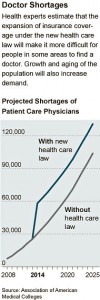Today’s New York Times includes a nice article by Annie Lowrey and Robert Pear on the coming already-here primary care doctor shortage. I have mixed feelings about the title, “Doctor Shortage Likely to Worsen With Health Law.” Pending expansions in access among the currently-uninsured is just one of many challenges facing the primary care system. Specific elements of the Affordable Care Act are helpful. Yet the magnitude of the overall challenge remains daunting.
As Lowrey and Pear observe, the economic, organizational, and professional challenges go pretty deep. Reimbursement disparities (and thus pay gaps) between cognitive and procedural forms of medical intervention are far too wide. The American health care system does not execute team care very well. We must deploy the skills of non-physicians more effectively. Medical students receive many negative messages about primary care in their training–not least as they witness many of their primary care mentors unhappy in their work.
Indeed the Time‘s key graphic (shown below) shows both sides of the story. I don’t know the details of the underlying model used to generate these estimates.* The two lines show the predicted/feared impact of health reform. What strikes me is the two ways one can read this graph….
 Viewing the lines vertically, health reform really appears to magnify the challenge. Viewing the same lines as a horizontal shift, the Affordable Care Act really accelerates the underlying trend by only a few years. Which reading is the right one? To some degree, both.
Viewing the lines vertically, health reform really appears to magnify the challenge. Viewing the same lines as a horizontal shift, the Affordable Care Act really accelerates the underlying trend by only a few years. Which reading is the right one? To some degree, both.
Tom Bodenheimer of UCSF is one of the nation’s leading authorities about both the challenges, and the prospects of improvement, in primary care.
In September 2010, Alice Chen, Vivek Murthy, and I interviewed him for Doctors for America. It’s a pretty interesting podcast on these issues, whatever your political or policy views regarding the new law.
*Commenters, I’d appreciate some references on physician workforce shortage models.
